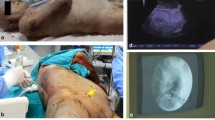Abstract
Introduction
Thiel’s embalming technique, first described by Thiel in 1992, conserves texture and colour in cadavers close to that observed in the living. It would appear that few anatomy laboratories use this method, and literature describing its use worldwide is sparse. The aim of our study was to conduct a worldwide survey on the use of this method.
Methods
A questionnaire was sent out by mail to 311 anatomy laboratories or institutes across the five continents. There were six multiple choice questions to assess the level of awareness of Thiel’s method, the frequency of its use among respondent institutions, the most frequently used solutions for conservation of cadavers and perceived obstacles to the use of Thiel’s technique.
Results
109/311 (35%) centres replied to the questionnaire; 56% of centres had previously heard of Thiel’s technique, but only 11 centres (10% of respondents) used it regularly, and all of these were in Europe. Formalin remains the most widely used conservation solution around the world.
Conclusions
Thiel’s embalming technique is not widely known, and therefore, little used. The main obstacle to its wider use is likely the language barrier, since most of the publications describing Thiel’s method are in German, which is not widely spoken outside of a few European countries.

Similar content being viewed by others
References
Alberty J, Filler TJ, Schmal F et al (2002) Thiel method fixed cadaver ears. A new procedure for graduate and continuing education in middle ear surgery. HNO 50:739–742
Anastasakis E, Kingman CE, Lee CA et al (2008) Menstrual problems in university students: an electronic mail survey. In Vivo 22:617–620
Benkhadra M, Bouchot A, Gerard J et al (2010) Flexibility of Thiel’s embalmed cadavers: the explanation is probably in the muscles. Surg Radiol Anat. doi:10.1007/s00276-010-0703-8
Benkhadra M, Faust A, Ladoire S et al (2009) Comparison of fresh and Thiel’s embalmed cadavers according to the suitability for ultrasound-guided regional anesthesia of the cervical region. Surg Radiol Anat 31:531–535
Benkhadra M, Lenfant F, Nemetz W et al (2008) A comparison of two emergency cricothyroidotomy kits in human cadavers. Anesth Analg 106:182–185 table of contents
Feigl G, Anderhuber F, Dorn C et al (2007) Evaluierung und Vergleich einer speziellen Trainingsmethode für Regionalanästhesisten. Anästhesist 56(5):437–444
Feigl G, Fuchs A, Gries M et al (2006) A supraomohyoidal plexus block designed to avoid complications. Surg Radiol Anat 28(4):403–408
Feigl GC, Fasel JH, Anderhuber F et al (2009) Superior vestibular neurectomy: a novel transmeatal approach for a denervation of the superior and lateral semicircular canals. Otol Neurotol 30:586–591
Hazard Munro B (2008) Statistical methods for health care research, 5th edn. Lippincott, Philadelphia
Holzle F, Franz EP, Lehmbrock J et al (2009) Thiel embalming technique: a valuable method for teaching oral surgery and implantology. Clin Implant Dent Relat Res. doi:10.1111/j.1708-8208.2009.00230.x
Krishnasamy M, Wilkie E, Haviland J (2001) Lung cancer health care needs assessment: patients’ and informal carers’ responses to a national mail questionnaire survey. Palliat Med 15:213–227
Lirk P, Colvin JM, Biebl M et al (2005) Evaluation of a cadaver workshop for education in regional anesthesia. Anaesthesist 54:327–332
Peuker ET, Werkmeister R, Pera F et al (2001) Surgical procedures in mouth, jaw and facial surgery in Thiel embalmed body donors. Mund Kiefer Gesichtschir 5:141–143
Thiel W (1992) An arterial substance for subsequent injection during the preservation of the whole corpse. Ann Anat 174:197–200
Thiel W (1992) The preservation of the whole corpse with natural color. Ann Anat 174:185–195
Thiel W (2002) Supplement to the conservation of an entire cadaver according to W. Thiel. Ann Anat 184(3):267–269
Viera AJ, Cohen LW, Mitchell CM et al (2008) Hypertensive patients’ use of blood pressure monitors stationed in pharmacies and other locations: a cross-sectional mail survey. BMC Health Serv Res 8:216
Windisch G, Ulz H, Feigl G (2009) Reliability of Tuffier’s line evaluated on cadaver specimens. Surg Radiol Anat 31:627–630
Wolff KD, Kesting M, Mucke T et al (2008) Thiel embalming technique: a valuable method for microvascular exercise and teaching of flap raising. Microsurgery 28:273–278
Conflict of interest
No conflict of interest has been declared.
Author information
Authors and Affiliations
Corresponding author
Rights and permissions
About this article
Cite this article
Benkhadra, M., Gérard, J., Genelot, D. et al. Is Thiel’s embalming method widely known? A world survey about its use. Surg Radiol Anat 33, 359–363 (2011). https://doi.org/10.1007/s00276-010-0705-6
Received:
Accepted:
Published:
Issue Date:
DOI: https://doi.org/10.1007/s00276-010-0705-6




